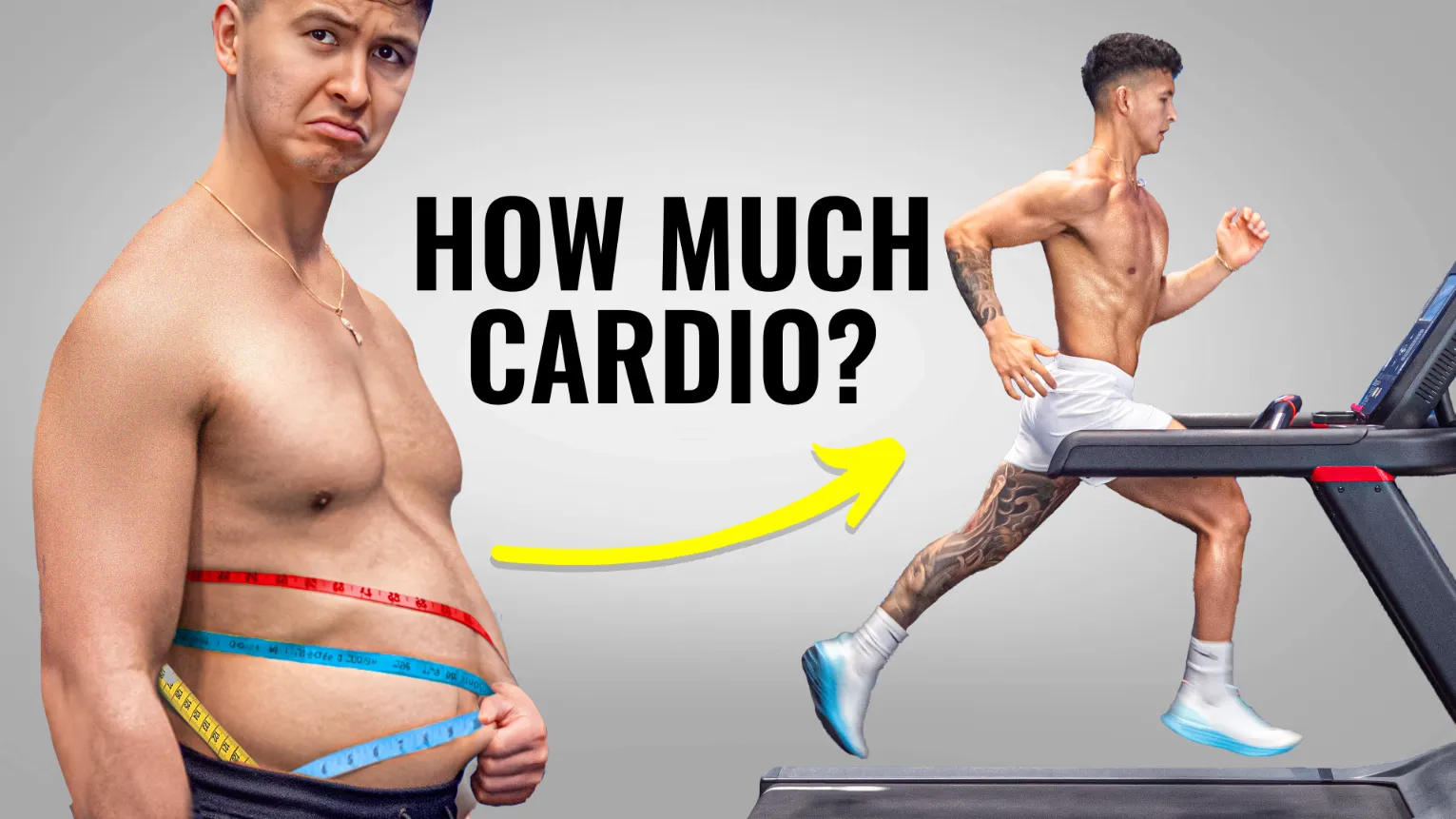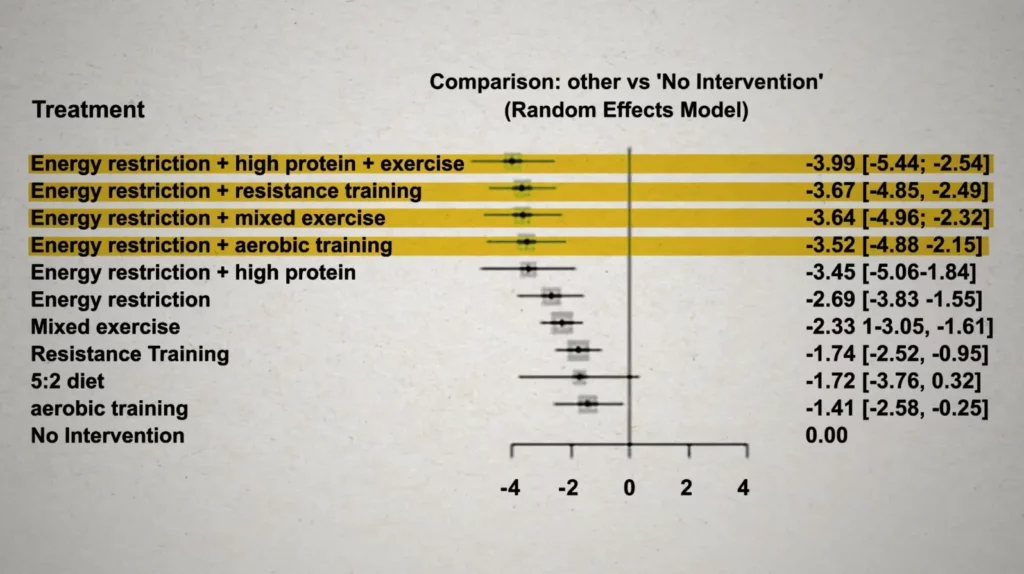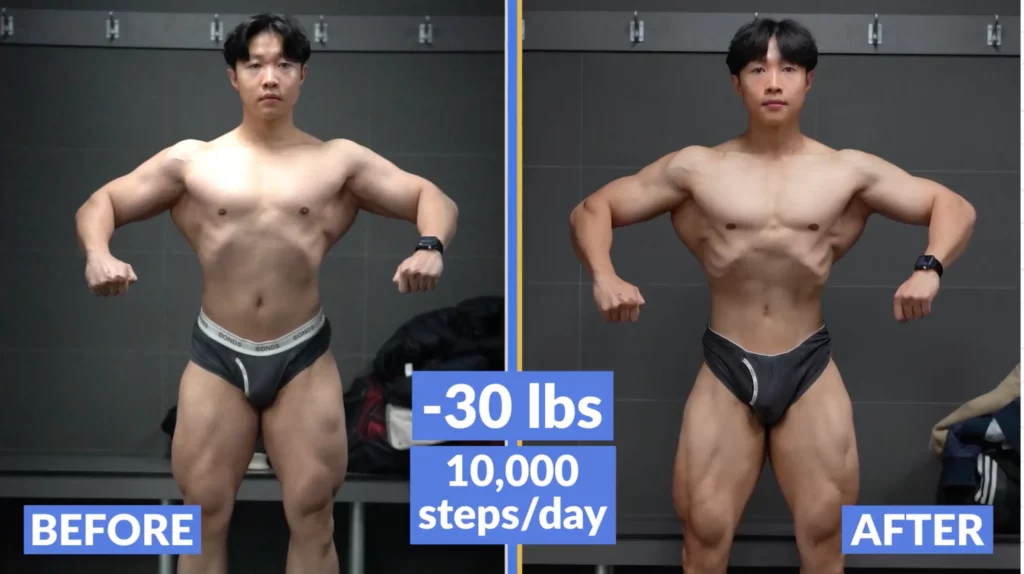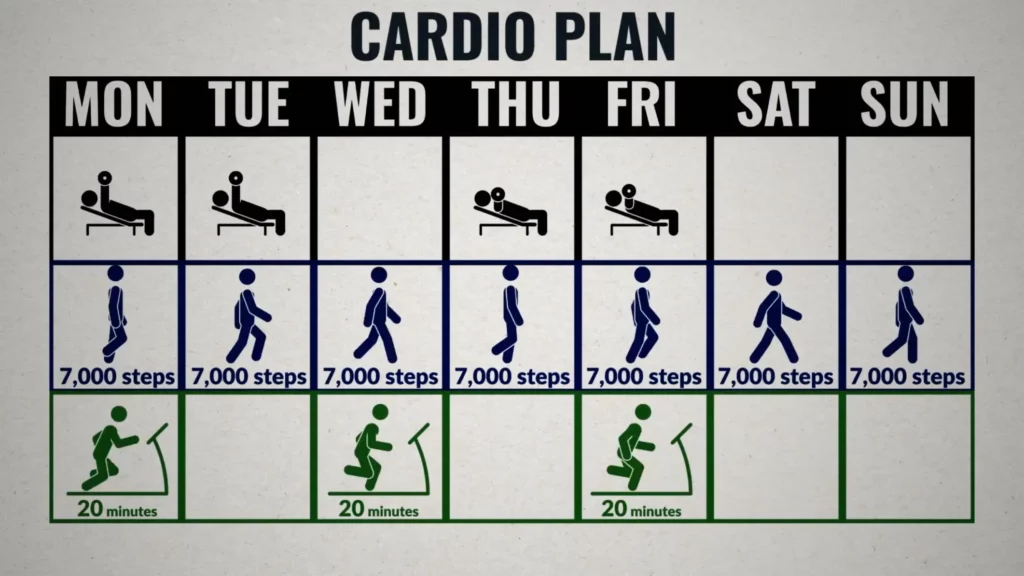
How Much Cardio Should You Do to Lose Weight? (Science Explained)
Do you need cardio to lose weight? After reviewing the latest science, interviewing the smartest experts in the world, and speaking to some of the top natural bodybuilders in the industry, here’s what I found.
Do you need cardio to lose weight? And how much cardio should you actually do?
Some say you don’t need any, whereas others say you gotta do it every day. I was determined to get to the bottom of it all.
Do We Even Need Cardio To Lose Weight?
Or, in other words, how helpful is cardio actually for weight and fat loss in the first place? The answer might surprise you.
While cardio is great for heart health and longevity and provides plenty of other benefits, it’s not nearly as effective as most people think when it comes to losing weight and fat.
At least in the way most people do it.
You see, typically, you’d expect if you did 300 calories worth of cardio, you’d burn 300 more calories that day.
But back in 2016, researcher Herman Pontzer published what’s known as the constrained energy model.
The model proposed that the more calories you burn through cardio, the more your body will try to save energy and burn fewer calories the rest of the day to protect its fat stores.
It does this subconsciously by:
- Decreasing your NEAT levels: E.g., taking fewer steps the rest of the day or little things like not moving your hands around when you’re talking.
- Increasing energy intake (diet compensation): Some people tend to subconsciously eat more in response to doing more cardio.
To the point where the 300 calories of cardio you did can theoretically cancel out completely.
Unfortunately, shortly after this research came out, it made it seem as if exercise was pointless for weight and fat loss.
Although an exaggeration, the compensation effect is definitely real and well-documented.
Most research has shown that people who start doing cardio without any changes to their diet tend to lose 20-50% of what they’d expect from the calories they’ve burned.
Meaning if you did 500 calories of cardio every single day and didn’t make any changes to your diet, you’d expect to lose a lb of fat after a week.
But because of various compensations, you’d probably only end up losing about 0.2 to half a pound at most.
This is generally why in studies where subjects don’t change their diet but simply do more cardio, they usually don’t actually end up seeing very great weight and fat loss results relative to the effort they’re putting in.
Is That True For All Cardio Types?
But you’re probably wondering, what about different types of cardio?
Surely sprints and HIIT-type workouts we see all the shredded influencers doing would be great for weight and fat loss, right?
Well, Daniel Plotkin, one of our BWS researchers, recently published a study comparing all different types of cardio on fat loss.

I'll let him explain his study and findings for himself:
So what we did is we took all the studies that we could find that compared high-intensity training (e.g., sprinting and cycling with high-intensity bouts) with low- and moderate-intensity aerobic exercise (e.g., incline walking and moderate-intensity cycling).
We wanted to see which of these created the most fat loss.
And at the end of it, what we found was that there was no difference between these two modalities at all, which wasn't super surprising.
But what was surprising is that whether it was high-intensity interval training or moderate-intensity training, there was essentially no fat loss effect. If you look at the actual raw numbers, when you compare exercise versus nothing, it's about 0.25 kilograms (0.5-something pounds) over 8 weeks of aerobic training.
So what we can conclude is that at least at these doses:
- 30 minutes or so per week of high-intensity training, or
- 120 minutes or so per week of moderate-intensity training
... cardio alone isn't very effective for fat loss.
What About Doing More Cardio To Lose Weight?
OK, but what about doing even higher amounts of cardio to lose weight? Would that work?
Well, in studies like this one by Ross and colleagues, it seems like very high doses of cardio, in this case doing 700 calories worth of cardio every single day, the equivalent of about 1 to 1 and a half hours of jogging, does lead to quite a bit of fat loss: 6.1 kg drop in body fat after 3 months.
So without changing your diet, you’ve probably got to do a whole lot of cardio for it to have a meaningful effect on fat loss.
Which isn’t a very efficient or realistic approach for most people.
But I didn’t write this article just to tell you that cardio doesn’t work. Because it does, but only when you use it properly.
To find out how exactly to do that, let’s take a look at this recent meta-analysis which ranked several different fat loss protocols from most to least effective.
Do Not Just Rely On Cardio To Lose Weight
As expected, cardio alone, with no changes to diet, was the least effective method.
But take a look at the most effective methods. Notice how they are all combinations of some form of exercise with a proper diet.

Which makes sense.
Think about how much easier it is to eat 500 calories less than it is to try to burn off 500 calories.
I illustrated this in my last article, where I ate at a bunch of McDonald’s and figured out the hard way just how difficult it was to burn off.
So don't just rely on cardio to lose weight.
Think of it rather as a supplemental tool that you can stack on top of your diet to speed things up.
How Much Cardio To Lose Weight?
But now that I’ve hopefully convinced you to start tracking and following a diet, how much cardio should you add to this?
Let’s start by asking the only people in the world who have truly mastered the art of controlling their diet while using cardio to get them into incredible shape, professional bodybuilders.
First, I spoke to Alberto Nunez.

An extremely knowledgeable coach and lifetime drug-free pro bodybuilder who’s known for getting into insane levels of leanness:
"I didn't use cardio to lose weight at all, really.
I'd rather diet a little bit longer, and like I said, I'd rather eat less than have to go perform some other sort of exercise, especially exercise that I don't necessarily enjoy. But this last prep, it was nice to actually do some cardio.
I'm like, oh, I get to eat a little bit more because I'm doing cardio.
I also feel that it helped with some of the recovery aspects because even though I know better, I'm prone to just after training, just being garbage and just like laying around."
I also spoke to Lee Lem, a natural bodybuilder just a few weeks out from his show.

"I honestly think that we could probably get through this entire prep without cardio to lose weight.
The other alternative was to not do cardio but then decrease calories further. But you know, like, the lower the calorie deficit, the less good you're gonna feel. So yeah, this is where we decided to do extra cardio."
So it turns out that by using either a longer or more aggressive diet, these guys didn't really need cardio to lose weight or get into crazy shape.
But including it had its benefits.
Now what also surprised me was the importance they placed on their daily step count and how they use it as part of their overall cardio plan.
The Importance Of Daily Steps For Weight Loss
Here's what Alberto had to say about that:
"Our bodies are fantastic at surviving, and they will figure out ways to slow down the rate of loss.
I first started noticing this with my athletes. As they were getting leaner, their rooms just started to get messier. You could see that they weren't doing much other than going to work, going to the gym, and then just couching it up.
So yeah, the step counts have a way of making you a little bit more plateau-resistant.
It's a great way to keep people moving when they're in these situations where they've been dieting long enough, doing cardio long enough, and their body's just figuring out ways to keep them sitting.
A lot of our actual modifications are going to come through diet and cardio.
The steps are just kind of there in place to make sure that you don't sloth around."
And here are Lee's thoughts:
"I'm the type of person who would either be at home playing games or be at the gym.
I was doing like hardly any steps at all. So like 2,000 steps per day.
When we started our prep, we were just like, okay, we need to start getting you to move around more. That way, we can keep your food as high as possible. So we initially started with 10,000 steps per day.
We lost roughly about 30 pounds until we started introducing cardio."

So it seems like these guys maintain a high daily step count not only as a way to burn more calories but to also make sure they don’t get lazier as they get leaner.
You might recall this as one of the compensations we talked about earlier.
What's Needed To Get Really Lean?
But now I wanted to find out, on top of daily steps, how much actual “cardio” is required to get really lean?
Here's Alberto's take:
"Usually the smaller the athlete, the more cardio we will have to do.
It helps so they can eat a little bit more, which is obviously gonna help with the mental component to some extent.
And then also with women, since they're smaller systems, they tend to clear up a lot of the fatigue that using cardio to lose weight might add to the situation.
I'm just like, wow, we're doing like an hour each day, six days a week, and you are still progressing with your training. Like, that blows my mind."
Alberto also emphasized that the amount of cardio to lose weight also depends on your lifestyle.
"I've had people do nothing. Nothing. And usually, this has to do with the occupation that if they don't move, they just get fired. So servers, personal trainers, labor-intensive jobs, things like that."
But for most of his clients, here’s what he’s found works best when using cardio to lose weight:
"7,000 steps on average as our baseline you have that set.
I'd say most people, per week, are going to require 4 to 5 days of cardio to lose weight, ranging anywhere between 30 to 45 minutes.
We're talking about pretty freaking lean. So roughly around like closing in on like 10% to 12% body fat for men. And you could add like 10% to that for women.
Like there's almost no exception, I feel, even with the steps."
This seemed to line up with Lee’s protocol as well.
On top of 10,000 steps a day and lifting weights 4 times a week, he’s also doing 5x 30 minutes of cardio to lose weight.
But remember, this isn't just to get “six-pack abs lean”.
We’re talking shredded.
And they don’t do this much cardio right away. They build up to it over time. Whenever fat loss has stalled, and they’re not making progress, that’s typically when they decide whether or not they should add more cardio.
Alberto says:
"I think this is where we'd let athletes decide.
They have a little control over what sort of suck they're signing up for. So probably not a bad idea to ask them, okay, what would be the least psychologically invasive thing to you on the rest of your life?
So I might consider cardio, or I might just consider cutting calories.
It depends on appetite too. Maybe my appetite's been like in check, so I'm like, all right, you know what, just slash those calories because that's gonna be the most passive one."
And here's Lee's experience:
"At around 6 weeks out, I was pretty hungry.
So rather than decreasing calories further to increase weight loss, we decided to, well, let's increase cardio. So we burn more calories essentially."
Did They Use A Specific Type Of Cardio To Lose Weight?
Now as for the type of cardio to lose weight, I found a common theme between both of them.
Alberto says:
"If you are gonna use cardio to lose weight, go for things with minimal impact. So things like bikes, ellipticals, things with no eccentric are ideal."
And Lee says:
"So we started doing cardio to lose weight, 20-minute sessions 4 times a week on the elliptical machine.
And that's just to kind of reduce as much fatigue as we can, especially since we're still trying to maintain strength or even try to progress inside of training."
Now the reason they place such importance on their weight training isn’t just because they want to look as jacked as possible.
You see, as you diet, your body will need to burn off either muscle, fat, or a combination of both for energy.
Although lifting weights doesn’t burn as many calories as cardio does, it does give your body a strong reason to hang onto the muscle you’ve got and basically tells your body to burn off your fat for energy instead.
This is probably why in the meta-analysis I showed earlier, you may have noticed that combining diet with resistance training was one of the most effective fat loss methods — performing even better than combining diet with just cardio.
So think of the holy trinity of fat loss as a combination of diet, lifting weights, and cardio on top of that.
And if you're wondering whether cardio kills muscle gains ... read this article.
So ... How Much Cardio To Lose Weight, Exactly?
Now as for how much cardio per week you should aim for?
What I’d recommend is just start with Alberto’s recommendation of walking 7,000 steps a day as a baseline. In combination with your diet and weight training, this alone should already be enough for you to start losing fat.
Once you’re consistent with that, try adding in cardio sessions to get your heart going and to speed up the process; 2 to 3 20-minute cardio sessions per week would be a good start.

And although Lee and Alberto recommend cycling or the elliptical, you have plenty of other options when it comes to the type of cardio to lose weight.
I personally love variety, both with the exercise and the intensity.
Some days I’ll do incline walking, some days cycling, sometimes I feel like running, and sometimes even swimming.
The key is to choose things you actually enjoy and can recover well from.
Now, from here, once your body adapts and you reach a stall in your progress using your current routine, you can choose to either eat a little bit less or add a little bit more cardio or steps to continue losing fat.
You basically repeat this process for as long as it takes for you to reach your desired level of body fat.
Now we did see, on average, how much cardio Alberto’s clients do towards the tail end of their diet, but remember, they’re getting VERY lean.
So please don’t just follow that blindly.
The amount of cardio you’ll end up needing will heavily depend on your goal, your body, and your lifestyle.
Do Not "Quit" Cardio Cold-Turkey
But I do have a word of caution.
The last thing you want to do is start doing a bunch of cardio to lose weight during your diet and then stop cold turkey as soon as it’s over. That’s actually when cardio becomes most important.
Here to explain this is well-known fitness scientist and natural bodybuilder Dr. Eric Helms.

"So after a weight loss phase, most people, unfortunately, are gonna regain at least a proportion of the weight that they lost.
However, what most people do, which is a mistake, is they stop doing the exercise they were doing as part of the cutting phase.
You don't have to maintain all of the cardio you were doing while cutting, but keeping a certain amount of activity going can prevent some of that weight regained from happening."
As for how exactly cardio prevents fat regain, Eric explained it seems to help with controlling your hunger and also slightly increases the number of daily calories you burn.
Now as for how much to continue doing, here’s what he recommends:
"There's a great systematic review that was recently published in 2019 in Medicine and Science and Sports and Exercise by Jack and colleagues.
They found that doing just 150 minutes or more per week of activity generally, which of course could be cardio, but if you're lifting weights, that counts as well, is sufficient to prevent weight gain. If you're already getting weightlifting and that amount, then we need to look at, okay, well, what's the maximum benefit I can get here?
Some of the meta-analyses that look specifically at cardio seem to show that there are some benefits that are probably maximized around getting 7,000 to 9,000 steps per day.
So the general recommendation is if you can fall somewhere in that 7,000 to 9,000 steps per day and you're also lifting weights, even just two or three times per week, you're probably getting the maximal benefits not only for weight loss maintenance but also for health."
Sustainability Is Key When Using Cardio To Lose Weight
This is why for long-term success, when choosing the type of cardio to lose weight, it’s so important to choose activities you can actually stick to.
Whether it's watching a movie on the treadmill, playing a sport, or just going for walks to start out, find something you can do regularly to get you moving.
Remember, cardio isn’t just something you should do during a diet, and you shouldn’t do it just for the fat loss benefits. I.e., don't just do cardio to lose weight!
Do it for your overall health and well-being.
I love lifting weights, but honestly, nothing makes me feel better both physically and mentally than a good cardio workout.
Learn to enjoy it and make it part of your lifestyle, as it’ll provide you with benefits for years to come.
TL;DR
- It's inefficient and unrealistic to do enough cardio to lose weight effectively.
- Combining dietary changes and cardio to lose weight works best.
- As for how much cardio to lose weight, I'd recommend 7,000 steps a day and 2-3x 20-minute cardio sessions weekly.
- Do cardio types you enjoy and can recover well from.
- After losing weight, prevent weight rebound by maintaining 7,000 to 9,000 steps per day and 2-3x of strength training weekly.
And for a science-based program that shows you week by week exactly what to eat and what workouts to do to get you into the best shape of your life, then ake our quiz to find what program is best for you and your body:
Click the button below to take my analysis quiz to discover the best program for you:
↓
Highly recommend reading this article next for a super easy-to-make, budget-friendly meal plan for fat loss, or read this for a step-by-step walking plan for fat loss that you can start doing today.
Thanks for sticking to the end, and I’ll see ya next time!








